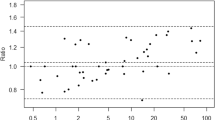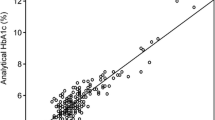Abstract
Objective
To compare the accuracy of fingerstick with laboratory venous plasma glucose measurements (laboratory glucose) in medical ICU patients and to determine the factors which interfere with the accuracy of fingerstick measurements.
Participants
The study included 80 consecutive patients aged 58 ± 7 years, BMI 29.5 ± 9.0, and APACHE II score 15 ± 6 (277 simultaneous paired measurements).
Measurements
This prospective observational study compared fingerstick measurements to simultaneously sampled laboratory glucose once a day in patients in our medical ICU (twice daily if on an insulin infusion). Data recorded included patient demographics, admission diagnoses, APACHE II score, BMI, daily hematocrit, arterial blood gasses, chemistry results, concomitant medications (including vasopressors and corticosteroids), and upper extremity edema. Accuracy was defined as the percentage of paired values not in accord (> 15 mg dl–1 / 0.83 mmol–1 l–1 difference for laboratory values < 75 mg dl–1 / 4.12 mmol–1 l–1 and > 20% difference for laboratory values ≥ 75 mg/dl). Outliers (blood glucose difference > 100 mg dl–1 / 5.56 mmol–1 l–1) were excluded from the correlation and distribution analyses.
Results
Mean fingerstick glucose was 129 ± 45 mg/dl (7.2 ± 2.5 mmol/l) and mean laboratory glucose 123 ± 44 mg/dl (6.8 ± 2.4 mmol/l). The correlation coefficient between the two values was 0.9110 (Clinical and Laboratory Standards Institute threshold 0.9751). The mean difference (bias) between the two methods was 8.6 ± 18.6 mg/dl (0.48 ± 1.0 mmol/l) and limits of agreement +45.8 and –28.6 mg/dl (+2.5 and –1.6 mmol/l). Fifty-three (19%) paired measurements in 22 patients were not in accord (CLSI threshold ≤ 5%). In 44 (83%) of these paired measurements fingerstick glucose was greater than laboratory glucose.
Conclusions
The findings suggest that capillary blood glucose as measured by fingerstick is inaccurate in critically ill ICU patients and does not meet the CLSI standard. It is unclear whether the sampling method, device used, or both contributed to this inaccuracy. The wide limits of agreement suggest that fingerstick measurements should be used with great caution in protocols of tight glycemic control.


Similar content being viewed by others
References
van den Berghe G, Wouters P, Weekers F, Verwaest C, Bruyninckx F, Schetz M, Vlasselaers D, Ferdinande P, Lauwers P, Bouillon R (2001) Intensive insulin therapy in critically ill patients. N Engl J Med 345:1359–1367
Kanji S, Buffie J, Hutton B, Bunting PS, Singh A, McDonald K, Fergusson D, McIntyre LA, Hebert PC (2005) Reliability of point-of-care testing for glucose measurement in critically ill adults. Crit Care Med 33:2778–2785
Chakravarthy SB, Markewitz BA, Lehman C, Orme JF (2005) Accuracy of glucose measurements in critically ill patients in shock (abstract). Chest 128:220S
Finkielman JD, Oyen LJ, Afessa B (2005) Agreement between bedside blood and plasma glucose measurement in the ICU setting. Chest 127:1749–1751
Kulkarni A, Saxena M, Price G, O'Leary MJ, Jacques T, Myburgh JA (2005) Analysis of blood glucose measurements using capillary and arterial blood samples in intensive care patients. Intensive Care Med 31:142–145
Vriesendorp TM, van Santen S, DeVries JH, de Jonge E, Rosendaal FR, Schultz MJ, Hoekstra JB (2006) Predisposing factors for hypoglycemia in the intensive care unit. Crit Care Med 34:96–101
van den Berghe G, Wilmer A, Hermans G, Meersseman W, Wouters PJ, Milants I, van Wijngaerden E, Bobbaers H, Bouillon R (2006) Intensive insulin therapy in the medical ICU. N Engl J Med 354:449–461
Critchell C, Callahan A, Aboud C, Jabbour S, Marik PE (2006) Accuracy of bedside capillary blood glucose measurements in critically ill patients (abstract). Crit Care Med 34(Suppl A):68
Marik PE, Varon J (2007) Intensive insulin therapy in the ICU: is it now time to jump off the bandwagon? Resuscitation 2007:191–193
Knaus WA, Draper EA, Wagner DP, Zimmerman JE (1985) APACHE II: a severity of disease classification system. Crit Care Med 13:818–828
Szczesny G, Olszewski WL (2003) The pathomechanism of posttraumatic edema of the lower limbs. II. Changes in the lymphatic system. J Trauma 55:350–354
Bland JM, Altman DG (1986) Statistical methods for assessing agreement between two methods of clinical measurement. Lancet I:307–310
Atkin SH, Dasmahapatra A, Jaker MA, Chorost MI, Reddy S (1991) Fingerstick glucose determination in shock. Ann Intern Med 114:1020–1024
Sylvain HF, Pokorny ME, English SM, Benson NH, Whitley TW, Ferenczy CJ, Harrison JG (1995) Accuracy of fingerstick glucose values in shock patients. Am J Crit Care 4:44–48
Brunkhorst FM, Wahl HG (2006) Blood glucose measurements in the critically ill: more than just a blood draw. Crit Care 10:178
Wiener K (1995) Whole blood glucose: what are we actually measuring? Ann Clin Biochem 32:1–8
Sidebottom RA, Williams PR, Kanarek KS (1982) Glucose determinations in plasma and serum: potential error related to increased hematocrit. Clin Chem 28:190–192
Fogh-Anderson N, D'Orazio P (1998) Proposal for standardizing direct-reading biosensors for blood glucose. Clin Chem 44:655–659
Sazama K, Robertson EA, Chesler RA (1979) Is antiglycolysis required for routine glucose analysis? Clin Chem 25:2038–2039
Tang Z, Louie RF, Lee JH, Lee DM, Miller EE, Kost GJ (2001) Oxygen effects on glucose meter measurements with glucose dehydrogenase- and oxidase-based test strips for point-of-care testing. Crit Care Med 29:1062–1070
Tang Z, Du X, Louie RF, Kost GJ (2000) Effects of drugs on glucose measurements with handheld glucose meters and a portable glucose analyzer. Am J Clin Pathol 113:75–86
Acknowledgements
The authors are indebted to the dedication of the ICU nurses and medical technicians whose dedication made this project possible. We also acknowledge Dr. Vidya Choudary who assisted with data collection. The authors have no financial interest in any of the products mentioned in this study.
Author information
Authors and Affiliations
Corresponding author
Rights and permissions
About this article
Cite this article
Critchell, C.D., Savarese, V., Callahan, A. et al. Accuracy of bedside capillary blood glucose measurements in critically ill patients. Intensive Care Med 33, 2079–2084 (2007). https://doi.org/10.1007/s00134-007-0835-4
Received:
Accepted:
Published:
Issue Date:
DOI: https://doi.org/10.1007/s00134-007-0835-4




